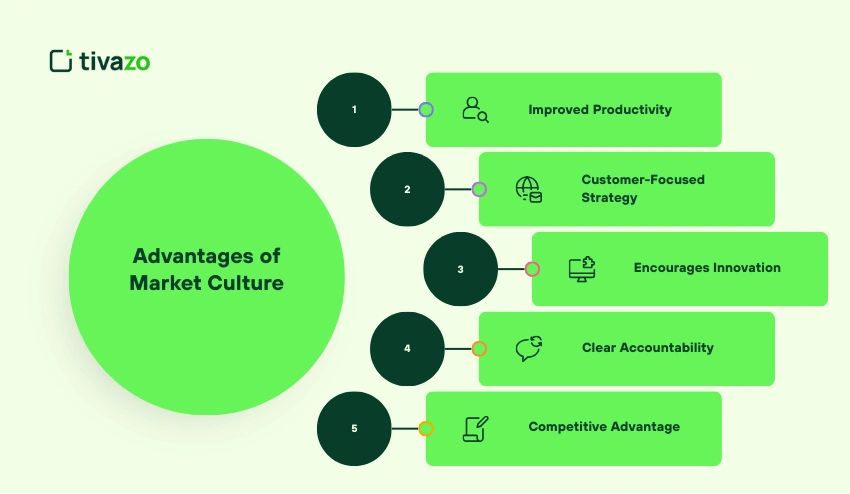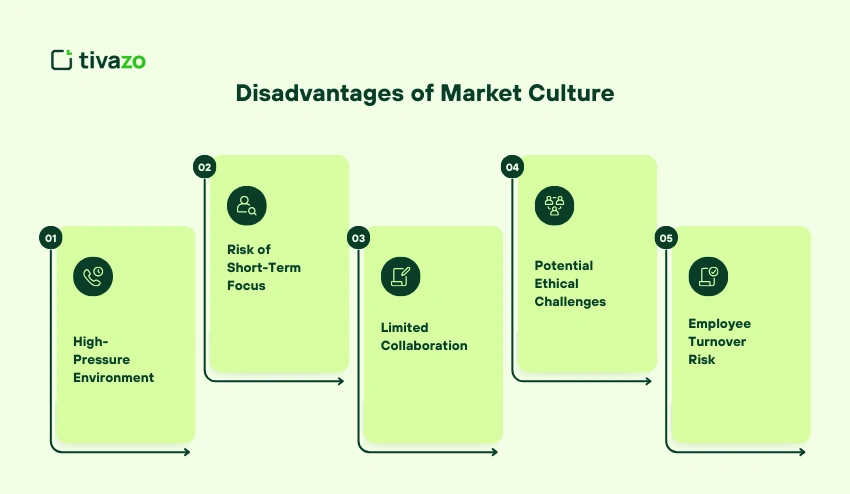Behind every successful organization, there is an engine of development,for example, the market culture. It is the hidden ingredient that can transform the strategies into outcomes and employees into high performers.
A results-based culture is a culture of the market, which brings about employee, leadership, and business convergence, which will help the business beat its competition. Promoting a performance culture helps organizations to increase productivity, concentrate on the needs of the customers, and create a profit-oriented culture oriented towards sustainable growth.
High-performing organizations are based on their market culture. It provides a goal-oriented, results-driven working environment in which the leadership, employees, and strategy are aligned to increase productivity and profitability. Businesses that have a strong market-oriented culture focus on performance-based methods, innovation, and a profit-oriented mentality. With the market-based management approach, the businesses remain externally oriented, are more efficient, and achieve sustainable growth. The development of the appropriate market culture is key to success in the long run.
👉You May Also Like: What Are the Different Types of Workplace Culture?
What is Market Culture?
Market culture refers to an organizational environment where business decisions, employee behaviors, and company strategies are guided by results, competition, and customer focus. In a market-oriented culture, companies prioritize achieving targets, improving performance, and maintaining a profit-oriented mindset. This type of culture emphasizes performance-driven approaches, accountability, and alignment between leadership and teams to ensure efficiency and growth.
What does the market culture focus on?
The culture of the market is mainly result-driven, competitive, and goal-oriented, with a customer orientation of organizational objectives. Organizations that have a high market-oriented culture focus on performance-based strategies, and in such a case, each team member will have the responsibility to ensure that consistent outcomes are attained. Such emphasis would involve the establishment of a goal-oriented workplace environment, a sense of responsibility, and a profit motive that encourages the employees to give their best. Using efficiency and productivity as the priority, organizations may get ahead of their competitors and lead the sustainable development.
There is also the market culture that focuses on innovation, strategic planning, and alignment of leadership. The use of market-based management practices enables businesses to be externally oriented, respond to market trends, and maximize business strategies to have the greatest impact. It could be better customer satisfaction, or it could be the increase in sales or the operational efficiency, but in a good market culture, all the organs of the organization are coordinated to bring success in the long run.
Market Culture Advantages and Disadvantages
Advantages of market culture
Having a good market culture aids organizations to remain competitive as it focuses on strategies, leadership as well and employees towards quantifiable outcomes. It creates a performance-based and goal-oriented working environment, which guarantees productivity and long-term business expansion.

1. Improved Productivity
Among the greatest benefits of market culture, one can mention the fact that it enhances productivity at every level of a company. Through the focus on the results, employees would be directed to work on the tasks that influence the business targets directly to reduce the amount of wasted labor.
A performance-driven working environment encourages the members of a team to have specific targets and keep monitoring their performance. This transparency allows employees to focus on high-value activities and resources, and time will be utilized effectively.
This systematic attention over a period of time results in accountability and performance culture. A high-performance driven culture in organizations is usually associated with a quantifiable increase in production, efficiency in operations, and overall performance of the business.
📖Read More: What Is Hierarchy Culture and Why Does It Matter in Organizations?
2. Customer-Focused Strategy
The market culture focuses more on the alignment of business processes to the needs of customers, and this makes businesses more sensitive to market needs. Market-oriented companies vigorously seek information about their customers and make changes to products and services to match the demands.
Profit-oriented thinking and customer orientation make sure that the strategies are sustainable and growth-based. Customer-listening businesses can enhance the levels of satisfaction, customer loyalty, and competitive edge in their business sectors.
Companies can ensure a stronger presence in the long-term market by considering the feedback provided by their customers in decision-making. These insights are inherently used by a results-driven organization to do more with less and bring about success.
3. Encourages Innovation
The market culture fosters the culture of innovation by encouraging a performance-based and results-oriented culture. Workers and managers are encouraged to come up with innovative ways of solving problems, which can be used to attain business goals in a more effective manner.
Companies that focus on market-based management also promote trial and error and risk-taking on a calculated basis. This will create a culture of appreciation of new ideas, and the culture of continuous improvement becomes a part of operations.
Creativity in the workplace is goal-oriented; it enables a business to be fast in adapting to the emerging market trends. Firms that have a high market-oriented culture are able to introduce new products, streamline their processes, and be ahead of the competition at all times.
4. Clear Accountability
Market culture is defined by accountability and has made the responsibilities of every employee clear. Results-oriented strategy enables leaders to track the progress and offer constructive feedback to keep teams on the right track towards achieving business objectives.
Establishes performance standards and sets clear goals/targets to be achieved in a set timeframe. A goal-based work environment eliminates confusion since it establishes clear objectives and creates performance benchmarks. Employees realize the effect of their contribution to the overall success, hence they become more engaged and own it.
This formalized responsibility is also a plus in enabling a profit-oriented mentality, since teams are concerned with real outcomes and efficiency. The culture of a strong market makes companies very disciplined, reliable, and long-term performance.
5. Competitive Advantage
A strong market culture can be implemented to provide organizations with a competitive advantage. With a performance-oriented strategy, organisations are able to react quickly to changes in the market and stay ahead of their respective markets.
A culture oriented towards the market incorporates customer insights, strategic planning, as well as innovation, which contributes to the ability of the businesses to outdo the others. The teams will be in sync, motivated, and empowered to deliver quantifiable results and contribute to the overall success of the organization.
By managing performance through the market-based approach and placing a results-oriented culture, companies are able to help sustain long-term growth while remaining operationally efficient. The combination they have guarantees them the lead in both performance and market relevance.
The market culture strengths are that it brings about an organization that is performance-based and result-oriented. It will enable businesses to gain the tools to ensure sustainable growth and a high position in the market, as well as to be more productive, innovative, customer-oriented, and more responsible.
Disadvantages of Market Culture
Although the market culture influences performance and outcomes, it may be a problem for organizations as well. The spirit of high competition and results can occasionally result in stress and shortcuts among employees.

1. High-Pressure Environment
A disadvantage of the market culture is that it may cause a high-pressure environment. The focus on performance-based strategies and the achievement of high expectations may put pressure on workers and impact morale.
The fact that in a goal-oriented working environment, the emphasis on the targets can always be observed, without being supported or rewarded, can result in burnout or low job satisfaction. Employees might also believe that they can only be valued based on the outcome and not their contribution in general.
This stress may affect the sustained productivity and retention. Organizations that have a market-oriented culture must put in place strategies that ensure that they do not motivate the employees at the expense of their well-being.
2. Risk of Short-Term Focus
A market culture may tend to promote a short-term orientation on short-term outcomes instead of long-term growth. Organizations can focus on making quick wins to achieve performance targets without considering strategic investments or innovation.
Focusing on profit-oriented mentality and quantifiable results, firms can unconsciously overlook the idea of sustainability or employee training programs. In the long run, the practice will restrict creativity and organizational resilience.
It is important to balance performance in the short term with market-based management and long-term planning. Companies that would not do it would be at risk of compromising their competitive edge and general growth potential.
3. Limited Collaboration
Teamwork and collaboration may be superseded by individual performance in very competitive market cultures. Employees can work to achieve individual goals instead of collective achievement, which affects the overall synergy of the organisation.
An environment where the workplace is results-driven, goal-focused, and compensates individual achievements may not necessarily encourage knowledge-sharing or collaboration. This may lead to silos, a decline in innovation, and make it difficult to make effective decisions.
In order to curb this, firms have to promote performance-based practices, as well as foster cooperation. The balanced market culture is efficient yet does not compromise teamwork or organizational unity.
4. Potential Ethical Challenges
A market culture that has a high emphasis on results can create ethical dilemmas in certain cases. Leaders or employees may make profits more important than ethical considerations to achieve targets, and this affects the reputation and trust.
Companies that focus on a profit-driven mentality should make sure that the outcomes-oriented strategies do not prejudice integrity and compliance. The absence of clear ethical standards may lead to the destruction of credibility in the long term at the expense of immediate profits.
This is achieved through the use of market-based management, where ethical frameworks are clearly enforced to ensure that there is accountability. This guarantees the business performance is in line with the results as well as responsible practice.
5. Employee Turnover Risk
The first con of market culture is that it puts the organization at a greater risk of losing its staff. The incessant focus on performance, targets, and competition may cause dissatisfaction in employees who experience pressure or underestimation.
In a goal-oriented work environment, individuals who can not match up to the high expectations can feel stressed or experience burnout, and they are likely to find a way out. Even the high performers may quit when they feel that the work culture is focused on results and not well-being.
This attrition may interfere with team cohesion, escalate recruiting expenses, and affect the organizational knowledge. Organizations that have a market-driven culture should have measures to maintain a balance between performance-related strategies and the needs of employees to retain them and achieve long-term sustainability.
Market Culture Examples
Example 1: Amazon
The example of Amazon is an excellent demonstration of a market-oriented culture. The company focuses on a goal-oriented, results-driven work environment, where each worker is oriented towards the company’s business goals, as well as on performance indicators. Amazon is an ever-innovative company that constantly changes and adjusts to market trends by creating a culture of performance and profitability. The principles of market-based management are reflected in the direction of the leadership, which is dedicated to accountability, efficiency, and customer satisfaction.

Example 2: Salesforce
The market culture is also exemplified by Salesforce1. The company is customer-focused and responsive to measurable outcomes, and customer-oriented strategies align the teams with the business objectives. Salesforce is very productive, and the results-oriented workplace is promoted by promoting innovation, a goal-oriented workplace, and performance-focused strategies. Their focus on efficiency, the orientation of leadership, and a market-oriented mind enable them to react well to market changes and, at the same time, grow in the long term.
Market Culture in Business
Market culture in business can be defined as an organizational culture in which decisions, strategies, and behaviors of employees are guided by results, competition, and customer orientations. Firms that have a market-oriented culture have a culture that has a strong focus on measurable results with a goal-oriented work environment that promotes accountability, efficiency, and high performance. Through performance-based strategies and market intelligence tools, companies are in control of aligning their leadership and teams to meet their strategic goals and long-term development.
Practically, firms that have a high market culture place emphasis on profit-oriented ways of thinking, innovation, and being outwardly oriented. This culture encourages the employees to do their best, and customer needs must be in mind. Organizations embracing the market-based management principles are capable of responding quickly to changes in the market, maximizing business strategies, and ensuring a competitive advantage.
Finally, business strategies need to incorporate market culture to facilitate the transfer of strategy into outcome, increase productivity, and develop a sustainable and high-performance organization that succeeds in the competitive industries.
Leadership Styles that Thrive in Market Culture
- Transformational Leadership
- Inspires employees to exceed expectations and embrace a results-driven, goal-oriented workplace.
- Encourages innovation, accountability, and a performance-driven culture across teams.
- Aligns leadership, employees, and business goals to maintain a profit-oriented mindset and sustainable growth.
- Transactional Leadership
- Focuses on setting measurable targets and monitoring outcomes to reinforce a results-focused culture.
- Rewards performance and ensures accountability in a market-oriented, goal-driven workplace.
- Supports market-based management principles, helping companies respond efficiently to competition and optimize business strategies.
- Servant Leadership (Optional Adaptation)
- Promotes team support and development while maintaining performance expectations.
- Balances employee well-being with a performance-driven, results-oriented approach.
- Strengthens engagement in a market culture, improving productivity and long-term retention.
👉You May Also Like: 7 Best Different Leadership Theories You Need To Know
Impact of Market Culture on Innovation & Creativity
The culture of innovation is driven by a good market culture in that it brings about a results culture, a goal-oriented workplace in which the employees are encouraged to seek innovative ways of enhancing efficiency and even profitability.
Leadership that meets the market-based management favors experimentation with accountability, making sure that the idea is pragmatic and results-oriented.
Overemphasis on the short-term outcomes, however, may be a drag on creativity. The ability to reconcile the profit-oriented mentality and the chances of collaboration and innovating assists organizations in translating ideas into practical strategies that will continue to grow.
Conclusion
To sum up, market culture is one of the most crucial determinants of business success, as it helps the company create a results-driven and goal-focused work environment that enables the leadership, staff, and strategies to work together to deliver concrete results. Although it has some benefits like increased productivity, innovation, and a competitive advantage, it also comes with such drawbacks as a high-pressure environment and possible turnover. Using the combination of a performance-driven and profit-oriented culture with teamwork, ethics, and support of employees, organizations will be able to utilize the full potential of the market culture to achieve sustainable growth and success in the long term.




